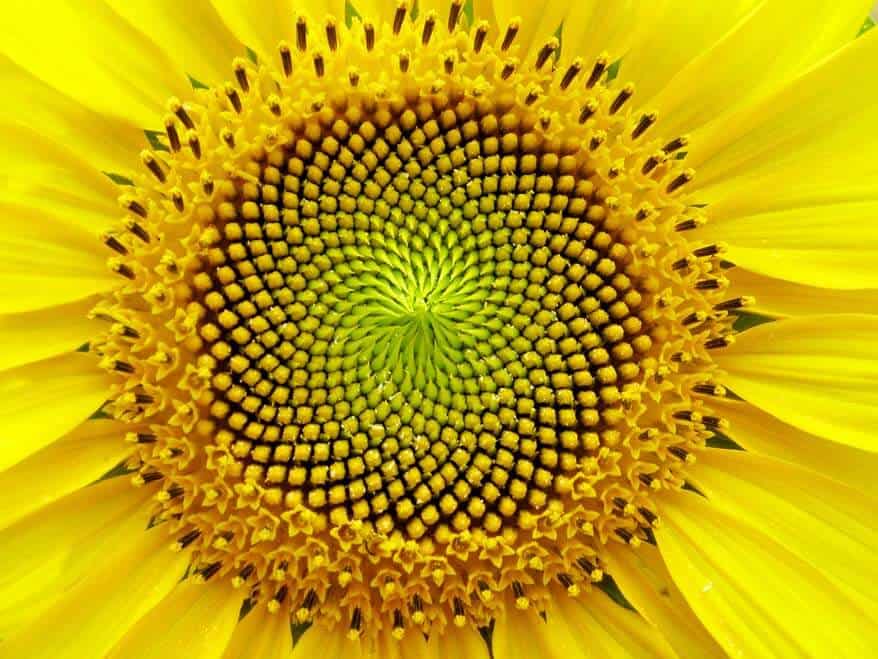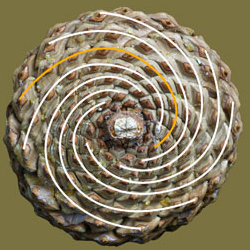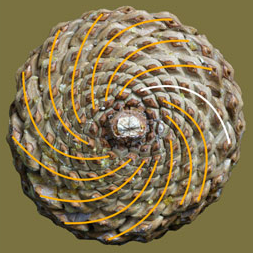| Line 11: | Line 11: | ||
A study was run with a sample pool of all pine trees in Norway to determine the phyllotaxis of their pine cones. The focus was on the bottom region of the pine cone where spirals can be easily observed. The result of the study found that 95% of the patterns resulted in Fibonacci numbers, 4% resulted in Lucas numbers (same recursive definition as Fibonacci, and also has a ratio which converges to the Golden Ratio), and the final 1% of patterns resulted in neither<sup>[https://www.princeton.edu/~akosmrlj/MAE545_S2017/lecture12_slides.pdf (1)]</sup>. An example of how these relationships were determined is shown below: | A study was run with a sample pool of all pine trees in Norway to determine the phyllotaxis of their pine cones. The focus was on the bottom region of the pine cone where spirals can be easily observed. The result of the study found that 95% of the patterns resulted in Fibonacci numbers, 4% resulted in Lucas numbers (same recursive definition as Fibonacci, and also has a ratio which converges to the Golden Ratio), and the final 1% of patterns resulted in neither<sup>[https://www.princeton.edu/~akosmrlj/MAE545_S2017/lecture12_slides.pdf (1)]</sup>. An example of how these relationships were determined is shown below: | ||
| − | <center>[[File:MA279Fall2018Topic1_PineconeCCW. | + | <center>[[File:MA279Fall2018Topic1_PineconeCCW.png]][[File:MA279Fall2018Topic1_PineconeCW.png]]</center> |
Counting first the spirals in the direction shown in the first picture, we can count 13 unique spirals. In the opposite direction--those shown in the second picture--we only count 8 unique spirals. These numbers happen to be consecutive Fibonacci numbers, namely the sixth and the seventh Fibonacci numbers. | Counting first the spirals in the direction shown in the first picture, we can count 13 unique spirals. In the opposite direction--those shown in the second picture--we only count 8 unique spirals. These numbers happen to be consecutive Fibonacci numbers, namely the sixth and the seventh Fibonacci numbers. | ||
[[Walther MA279 Fall2018 topic1|Back to Walther MA279 Fall2018 topic1]] | [[Walther MA279 Fall2018 topic1|Back to Walther MA279 Fall2018 topic1]] | ||
[[Category:MA279Fall2018Walther]] | [[Category:MA279Fall2018Walther]] | ||
Revision as of 15:47, 28 November 2018
Phyllotaxis

In the field of botany, one of the most spectacular concepts--in terms of both beauty and mathematics--is the pattern with which leaves appear on the stems of plants. This concept is referred to as phyllotaxis. There is a great deal that has been noticed and understood regarding phyllotaxis within the past century, and the knowledge we have gained has spilled over into the field of applied mathematics in physics.
An ideal example comes in the form of the arrangement of sunflower seeds. Spirals can be immediately noticed in the pattern, but following these spirals towards the center eventually leads to a decidedly chaotic region. It is the spirals, however, that we are interested in. Analysis of the numbers of spirals within phyllotaxis often yields relations to Fibonacci numbers.
There seems to be a tendency for the number of spirals going in one direction and the number of spirals going in the other direction to be consecutive Fibonacci numbers. This is not only the case for the sunflower, but also for a great many other phyllotaxis patterns.
A study was run with a sample pool of all pine trees in Norway to determine the phyllotaxis of their pine cones. The focus was on the bottom region of the pine cone where spirals can be easily observed. The result of the study found that 95% of the patterns resulted in Fibonacci numbers, 4% resulted in Lucas numbers (same recursive definition as Fibonacci, and also has a ratio which converges to the Golden Ratio), and the final 1% of patterns resulted in neither(1). An example of how these relationships were determined is shown below:


Counting first the spirals in the direction shown in the first picture, we can count 13 unique spirals. In the opposite direction--those shown in the second picture--we only count 8 unique spirals. These numbers happen to be consecutive Fibonacci numbers, namely the sixth and the seventh Fibonacci numbers.

